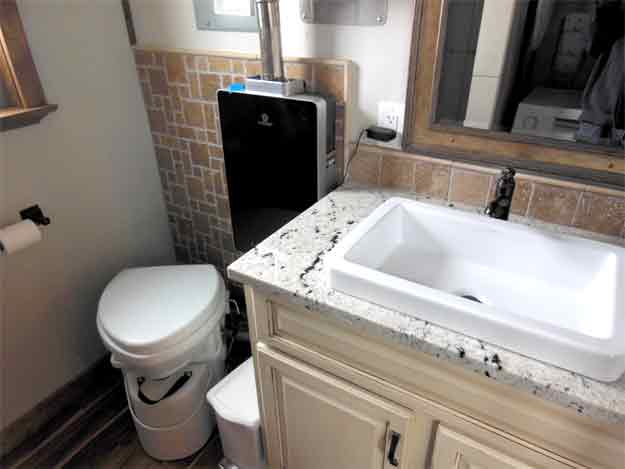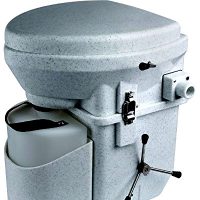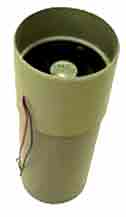Composting Toilets for Tiny Houses and RV’s
The Good, The Bad, and the Ugly of Waste Management
“It doesn’t smell at all!” they exclaim. Proponents of composting toilets are quick to offer their observations/justifications for this popular bathroom fixture. Since they negate the need for plumbing and/or a black-water holding tank, these devices have been given the stature of a silver bullet for saving money on construction costs. But what do you do with the waste once the tanks are full?
This is actually a hot topic for many websites dedicated to just this issue. Some folks toss it out with the trash. However, about half the states have regulations prohibiting that. What you do with it on your own property can also be highly regulated. Many counties in my state ban their use completely. They don’t want piles of human poop lying around your property. Here’s an article from a lady who’s research says it’s OK to dump it in the trash.
On this page, we’ll take a comprehensive look at pros and cons of these popular toilets, as well as other options for waste removal in your tiny home.
Composting Toilets Don’t Actually Compost Your Poop
I’m not sure why they call these “composting” toilets. They don’t do that. They do somewhat begin the process by separating the urine and adding a source of carbon like sawdust, coconut coir, or peat moss.
Turning poop into safe compost is a difficult task that can take up to eighteen months. Even then, without heating you’ll have a lot of nasty microorganisms that can despoil the environment and make you sick. Remember getting “the revenge” when you vacationed in Mexico?
Can you tell I’m not excited about these devices? Think about how you will be using your tiny home. Will you be renting space in an RV park? Chances are they will not let you in unless you are plumbed like an RV, with holding tanks and a drain fitting that matches their facilities.
The Advantages of Composting (or “dry”) Toilets
The biggest advantage of composting toilets is cost. You do not need a black water holding tank, or much of any plumbing. Some people are adding a urine diverter which shunts urine to the grey water disposal system. Unfortunately, this sometimes means that it’s just drained out of the house into the grass without a filter system.
There is a vent that needs to be plumbed in and they often need a power source (some do not need power) but that’s about it.
They save a lot of water. If you’re off-grid your fresh water will last longer.
Personal Experience with a Composting Toilet
Here is a great YouTube video discussing the reality of a composting toilet:
Here are the best Composting Toilets
Nature’s Head Composting Toilets
Nature’s Head Composting Toilets are the most popular waterless, urine separator composting toilets on the market. I’m not sure why. They’re not the most reasonably priced and they have a very utilitarian atheistic.
The retail price of the Nature’s Head composting toilet is $1,299.00* but last I checked it was sale priced at $1,065.00.* It comes with a 5-pack of Coco Coir.
Coco Coir is used as a bulking material in the composting toilet. It’s a great medium for the bacteria to thrive without adding bug larvae that sometimes comes with products like sphagnum moss.
There is a handle on the side used to mix or turn the solid waste area to add oxygen and aid in decomposition. This can be a difficult chore for those of us with limited mobility.
The Separett® Composting Toilet
From the Separett Manufacturer:
“The Villa 9215 is designed to accept 12V DC power from battery or solar resource,
or with the included AC adapter to run on standard AC power. It’s the perfect unit if you may be changing from on grid to off or vise versa. This is the unit most commonly used for Tiny Homes as the fan draws less air for smaller spaces.
The Separett Villas are urine diverting toilets. The design of the toilet bowl catches the urine in a drain which is plumbed to a grey water system or holding tank. The solid waste and paper only are contained within the solid waste holding area in a compostable liner bag. There’s no cranking or need to add bulk material.
The vent fan pulls air over the solid waste holding area, serving to help dry the solid waste and vent any odor. After a period of use – generally about 3 weeks for average family use, the compostable liner bag is removed from the solid waste holding area and is deposited in your composter, approved solid waste disposal area, or incinerated.”
The Separett Villa sells for $989.00* through this factory-direct link.
Composting Toilet Designed Especially for Tiny House Builders
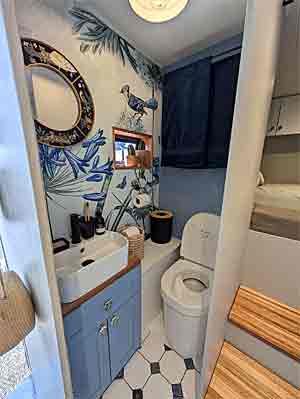
Tiny® is the latest addition to the Separett family of toilets. The smaller design and lessons learned from several decades have led to a modern urine separation toilet that is especially suitable for installations where space is limited.
Thanks to urine separation the smell is significantly reduced. What comes out is exhaust air from the 1.5″ (schedule 40) ventilation pipe. When used by 2 people, the solids container needs emptying once a week. With two users the urine container needs emptying about every other day. You can buy multiple urine containers as well as solid waste containers if you are not going to be near a disposal facility for some time.
There’s even a child size seat for it. The folks have thought this through.
The cost through these factory-direct links is $999.00. There is financing available.
There is a version that has a urine drain tube instead of the container for $999.00. Sometimes people who are installing these in an RV that already has a black tank fine it easier to empty the black tank from the outside. Black tanks hold a lot more so you don’t have to dump as often.
BioLet Composting Toilets
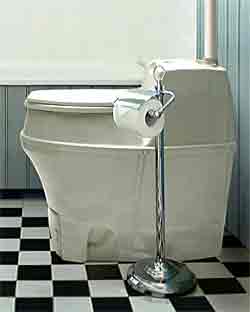
Biolet was one of the first companies to make composting toilets. They have over40+ years experience. BioLet composting toilets are some of the least expensive but most automatic composting toilets in the world.
The BioLet 55A, shown on the right, incorporates advanced technology to help speed up natures natural decomposition times.
This composting toilet is equipped with a quiet fan, double heaters, compost covers, and is completely automatic. The BioLet 55a ensures an optimum environment for care free operation. Rated at 3 – 4 people seasonal use the BioLet 55a is an excellent choice for tiny homes, permanent RV’s, or skoolies.
The BioLet 55a retails for between $2,300.00* and $3,000.00* depending on if it’s on sale or not. Right now through these links you can get it brand new for just $2,304.00* and there’s financing too.
Extra Capacity BioLet 65a composting toilet
For those who need extra capacity the BioLet 65a is the right choice. Rated for 4 people full-time use and 6 people part-time use, the BioLet 65a is perfect for your tiny house. With it’s fully automated operation, including an advanced active liquid control sensor, fan, and automatic mixer, it is easy to see that this toilet means business. Approved and certified by the world’s leading testing authorities, the BioLet 65a is clearly the most advanced and reliable composting toilet available.
The BioLet 65a is the only biological toilet to carry the Nordic Swan Ecolabel. This certification is the most prestigious approval in Scandinavia, the world’s largest market for composting toilets and is the most thorough testing for closed toilet systems in the world!
The retail price is $3,750.00* but thru these links you can get it for $3,049.00*. Includes a lifetime warranty for toilet body parts such as the try, tank, and base and a 3-year warranty for any toilet parts that have manufacturing defects.
Sunmar Composting Toilets
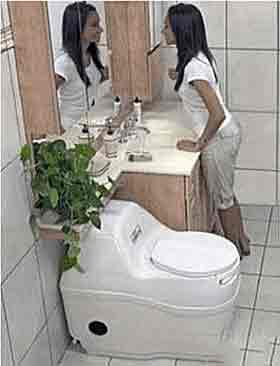
Sunmar composting toilets have more of a real composting system than other brands. They do offer the urine diverting type most others do but they also have a line that works a bit different.
These self contained composting toilets have a Bio-Drum™ that gets rotated every so often to oxygenate the compost bin. The compost is started by adding a bulking mixture like peat and a natural enzyme solution that assists aerobic decomposition of waste.
Urine and excess moisture is evaporated either by heating or naturally if you do not have electricity. Finished compost drops into a bin at the bottom of the unit and this is emptied. The compost Bio-Drum™ never needs to be emptied.
These composting toilets are a bit bulky because of the Bio-Drum™. You pick the size unit depending on how many people will be using it on a regular or part-time basis. There is a very large series that has a central composting unit that is meant to be installed in a basement or crawlspace.
Sun-Mar Initial Startup
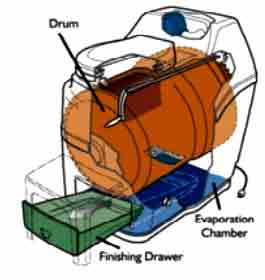
To begin use of the SunMar composting toilet you need to do a startup procedure then follow through with an ongoing maintenance routine. It usually takes about six weeks before a compost is properly established.
First add their bulking material called Compost Sure, then mix with the Microbe Mix Composting Accelerator. Add some water and plug it in. Spray Compost Quick Enzymes liquid into the drum and evaporation chamber.
The compost tuns black and becomes loam like fertile soil. Even toilet paper decomposes in just a few days.
For complete details of this procedure click here.
Carefully Consider Your Situation Before Choosing Your Toilet
If you will be permanently settled onto private property and can connect to a septic system or city sewer line with a municipal water supply, a standard household toilet is the right option.
The cost of adding a septic system, a well, and running electric to a property needs to be carefully considered in advance of your home choice. The infrastructure costs may more than double or triple the cost of the project.
Composting toilets may be the best choice for the school bus conversion tribe. Skoolie enthusiasts move frequently and are often near an outhouse into which they can empty their tanks.
Composting Toilets Downsides
There is definitely a place for a composting toilet but their are some downsides. Most of the problems can be corrected by installing correctly. However, with any of them you’ll need to be willing to be up close and personal with your poo during parts of the process.
Exhaust fan gets overwhelmed
Composting toilets have a fan to keep air flowing past the waste and out of the house. This is fine unless your house is so tightly insulated that there is no air inlet. The low level fan can easily be overwhelmed when you turn on your shower exhaust fan, or the exhaust fan over your gas stove. Then you might pull air backwards thru the exhaust vent and also up through the urine tube. Use the 4″ in-line booster fan to increase the exhaust air flow.
This 4″ in-line vent fan adds 9 CFM and uses only 2.4 watts at 12 volts. It’s very quiet. There are less expensive ones that move more air but they draw a lot more current and are noisy.
Urine is not as safe as some people claim
Some of the most respected tiny house authorities suggest you can just run the urine line out the bottom of the tiny house and drain it on the ground. Don’t do this. Do not drain it with your grey water either. It’s not safe or sanitary.
Urine isn’t actually sterile as most people claim. It does contain low levels of bacteria and needs to be disposed of correctly.
Flies and bugs are attracted to the exhaust tube
One tiny house friend ran her exhaust pipe up to the roof of her tiny home because she would smell the exhaust gasses if she opened her windows on that side of the house. Then she needed a more powerful fan (like the one shown here) to compensate for the longer distance tubing. She finally put a fine netting over the end of the pipe to keep flies and bugs from getting into the toilet. Still, for some reason, she likes her composting toilet.
Still Want a Composting Toilet? Here’s the Best Place to Get It
Shop Tiny Houses has a great selection with a great buyers guide .
With everything I’ve said about them you can tell it’s not going to be the right choice for me, but it might be just the right thing for you. So go for it.
More pages of the Tiny Life Consulting website you’ll be interested in:
Cassette Toilets Alternative to Composting Toilets
Composting Toilets and Zoning Laws


